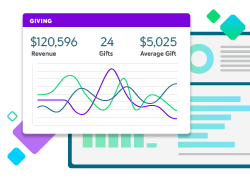8 Common Donation Page Mistakes (and Simple Solutions!)

Donors appreciate the convenience of making online contributions, and this trend shows no signs of slowing down. According to the Blackbaud Institute, online giving saw an increase of 8% in 2022 and 12% in 2023. To participate more fully in online giving, your website is your most crucial asset. And your website’s most important asset is your donation form. It’s important to keep your website updated to attract significant traffic and to feature your donation forms prominently on the main page.
Seems easy enough, right? In reality, a number of potential problems can stand between your organization and a thriving online giving program. Let’s explore the eight most common mistakes made on donation pages and simple solutions to fix them.
- Hidden donation forms
- Requiring donors to give too much information
- Cluttering your donation page
- Not highlighting your security policy
- Your donation page is not mobile friendly
- Not offering different giving levels and recurring gift options
- Paying for credit card fees
- Failing to say thank you
Mistake 1: Hidden donation forms
Make it easy for people to give. Clearly display a donate button on all relevant pages of your website, including the home page. Avoid hiding your donation form under menus or on less visible pages. This could reduce the number of donations you receive. If people must search for a way to donate, you’re at risk of losing their gift. Your donation page should be prominently featured on your website, and you should drive traffic to it through various promotional opportunities. Simple solutions:
- Include donation links in your email campaigns. While not every email should be a direct request for donations, some should include links to your donation form to make giving easy.
- Leverage social media. Many supporters are active on multiple social media platforms. In your next social media campaign, include links to your donation form where appropriate. Additionally, place the link in your bio on social media profiles.
- Ensure the donation process is obstacle-free. Even the most engaged supporters will become frustrated if they cannot easily find your “Donate Now” button.
Mistake 2: Requiring donors to give too much information
You may not always know what specifically drives a new prospect to your donation page, but something has piqued their interest. It could be a peer-to-peer effort where the prospect knows little about your mission. When your donation form is prominently displayed and easily accessible, you shouldn’t lose that gift. However, if the prospect must create a profile with your organization to make a one-time donation, chances are high that the donor won’t complete the donation. Collecting first-time donor information is important, but asking for too much could deter the donor from giving. Simple solutions:
- Choose a better donation form. Your form should fit your campaign type. For instance, Blackbaud Donation Forms offer two styles, Optimized and Standard Forms. For a Giving Tuesday campaign, where quick donations are crucial, the Optimized Form allows donors to give without creating a profile. For a capital campaign where information retention is key, the Standard Donation Form collects more donor information when accepting the gift. Matching the donation form to the campaign type makes giving easier for your targeted donor pool.
- Limit the required fields. It has been proven that adding just one extra field reduces the number of completed donation forms, and adding two or more additional fields can drastically drop your donation count. Therefore, choose your fields wisely and only ask for what you really need to process the gift.
Mistake 3: Cluttering your donation page
Your donation page should focus solely on facilitating donations. While your website serves as a platform for sharing success stories, videos, events, and updates on your mission, this type of content should not be on your donation page. When supporters visit your donation page, they are there to donate. Avoid distracting them. When you add too much content to your donation page, you are reducing the likelihood of them completing the donation. Simple solutions:
- Limit the text. Keep the copy to a few sentences.
- Highlight a single hero image. Your form should have only one photo. Make it a compelling one and place it at the top of the form.
- Tidy up the margins. Remove sidebar navigation and menus from the form so donors focus on submitting the gift.
Mistake 4: Not highlighting your security policy
If you don’t have a secure infrastructure, donors won’t feel safe sharing their personal information through your donation forms. Simple solutions:
- Use industry-standard safeguards. Work with a company that complies with Payment Card Industry Data Security Standards (PCI DSS) and Payment Application Data Security Standards (PA-DSS), at a minimum.
- Choose built-in fraud prevention. Choose a company that has invested in fraud mitigation tools.
- Show donors your security measures. Display compliance information on your donation page to reassure donors about the security of their transactions.
Mistake 5: Your donation page is not mobile friendly
Most online donations are made on mobile devices, so ensure your donation forms are mobile-friendly. Currently, 6.84 billion people globally own smartphones, and 50% of American citizens spend about five to six hours on their smartphones daily. If you rely solely on accepting donations through laptops and desktop computers, you’ll miss out on contributions from donors who prefer to give using their smartphones, tablets, and other mobile devices. Simple solutions:
- Make your form readable on a cell phone. When formatting for mobile devices, your form should be uncluttered and user-friendly. Include only a brief paragraph explaining your campaign and your logo on the form.
- Simpler is better. For the best user experience, your mobile-responsive donation page should be even simpler than your standard form. Use large, easy-to-click buttons and a vertical layout to eliminate the need for donors to pinch and zoom.
Mistake 6: Not offering different giving levels and recurring gift options
Research shows that offering different giving levels on your donation forms can lead to higher donation amounts. If you’re letting donors enter any amount, they’re likely to go with a less generous gift. Simple solutions:
- Provide predetermined giving levels. Link those levels to specific outcomes, helping donors feel more connected to your cause. For example, a donor might plan to give $25, but if they learn that a $50 donation achieves a particular outcome, they might decide to give more.
- Encourage recurring giving. Make sure your form prompts supporters to choose between a single gift or a recurring donation. This approach can help convert one-time donors into sustaining donors.
- Offer options beyond monthly giving. Statistics show that recurring donors typically prefer to give monthly, but some choose to give weekly, quarterly, or annually. By giving donors the option to turn their single gift into a recurring donation at the cadence they prefer, you can significantly increase the long-term benefits to your mission.
Mistake 7: Paying for credit card fees
The days of your organization needing to cover credit card fees are behind us. It is now acceptable for donors to cover the processing fees so that you receive 100% of their donation. But not all donors will choose to do this. Simple solution:
- Offer fee cover options. Select a donation form that gives donors the option to cover the fee, while ensuring that if they opt not to, the fee is still covered. Blackbaud Donation Forms feature Complete Cover™ and donor cover. With either choice, you’re making sure your credit card processing fees are covered, resulting in more revenue for your mission.
Mistake 8: Failing to say thank you
After a donor contributes, it’s essential to maintain ongoing communication and it all begins with a thank you. If you don’t have an automatic thank-you page, with a follow-up thank-you email, you’re missing an opportunity to nurture your relationships with online donors. Simple solutions:
- Customize your approach. The size of the donation determines the next step after an online gift is made. Even first-time donors who make a modest gift should receive information about upcoming fundraising events, engagement opportunities, and progress updates on your mission. Larger gifts should prompt more detailed and personalized communications.
- Create a stewardship plan. Having a well-defined stewardship plan is vital for sustaining donor relationships at every giving level and at every stage of your relationship.
Donation forms serve as the entry point for what may often be a donor’s initial contribution. Since first impressions are irreversible and you want a lifelong relationship with your supporters, it’s crucial that your donation page feels like you’re rolling out the welcome mat, thanking your online donors for coming and inviting them to stay for the good of your mission.
The Nonprofit CRM Built for Fundraisers
Find out how Blackbaud’s Raiser’s Edge NXT® fits your organization.

